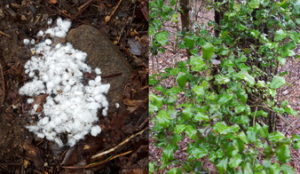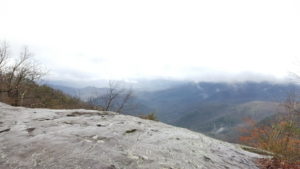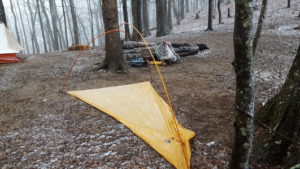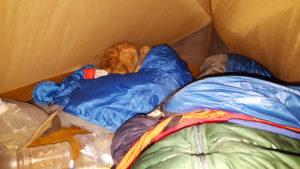TRAIL DAY 4 (CONT)
And so I saw “so many things” to quote Daniel Hockleitner from the movie “Witness” talking to Samuel before he boards the train for Philadelphia.
 In the “lowlands,” it was another overcast, rainy day containing its own natural miracles. Brilliant white in the midst of the dark, rain-soaked forest – little embryos? Mini cocoons? How did they get there? When? Then a shimmering green holly tree. Such color in the drab-but-glorious forest!
In the “lowlands,” it was another overcast, rainy day containing its own natural miracles. Brilliant white in the midst of the dark, rain-soaked forest – little embryos? Mini cocoons? How did they get there? When? Then a shimmering green holly tree. Such color in the drab-but-glorious forest!
Little did I know as I moved ever northward what lay ahead or where I’d sleep. And that’s the way I wanted it. I remember saying to a dear friend before heading south that I didn’t want to know what was around every corner or where I would sleep each night. I wanted to discover these things as I went. I wanted not to know.
 And so we came to the “rock ledges” and “views” atop Big Cedar Mountain at 3737′. We descended to Henry Gap and Jarrod Gap and then on to sawtooth climbing on the way to Woods Hole Shelter (0.2W). The side trail to the shelter and the layout around the shelter is as clear to me as if I were there yesterday. I can picture how the trail descended slightly and rose again, wrapping around a broad hillside until the shelter came into view far off to the right on a slight rise. It was around 5:30 p.m., a good time to stop, if not a little late for winter. It was getting colder and the shelter was full. Several hikers were setting up tents in flat areas at some distance from the opening to the three-sided shelter. I joined them.
And so we came to the “rock ledges” and “views” atop Big Cedar Mountain at 3737′. We descended to Henry Gap and Jarrod Gap and then on to sawtooth climbing on the way to Woods Hole Shelter (0.2W). The side trail to the shelter and the layout around the shelter is as clear to me as if I were there yesterday. I can picture how the trail descended slightly and rose again, wrapping around a broad hillside until the shelter came into view far off to the right on a slight rise. It was around 5:30 p.m., a good time to stop, if not a little late for winter. It was getting colder and the shelter was full. Several hikers were setting up tents in flat areas at some distance from the opening to the three-sided shelter. I joined them.
I cooked and ate inside my tent. Of course, cooking in a tent – always in the vestibule, off the tent floor and away from any material – is strictly verboten by all stove manufacturers. The fact that I manufactured my own stove didn’t change the danger. I took great pains to be careful and drew upon my tidy and minimalist instincts to manage well.
As I crawled in for the night, I put on every layer except rain gear against the cold which had settled in upon us. The temperature was in the teens at least, if not single digits – and the wind was howling like a train just outside the tent.
 I was a little extravagant regarding tents for my hike and purchased a second which I held in reserve. I started with a Big Agnes Fly Creek UL2 with a double wall. I had a footprint that fit under the floor for extra protection and minimal insulation. I would set up the light weight, collapsible aluminum tent poles securing their ends in loops at the extremities of the footprint. Next I suspended the tent from the flexed poles and fit its floor loops over the ends of the poles putting my foot or knee on the footprint to hold the opposite side in place as I removed the flexed end I was working with. Last was the rainfly which was a piece of thin nylon material quite complicated in design that fit over the flexed poles and clipped into female receptacles at the corners and the back center of the footprint. The entire tent with poles weighed in at approximately 2.2 lbs.
I was a little extravagant regarding tents for my hike and purchased a second which I held in reserve. I started with a Big Agnes Fly Creek UL2 with a double wall. I had a footprint that fit under the floor for extra protection and minimal insulation. I would set up the light weight, collapsible aluminum tent poles securing their ends in loops at the extremities of the footprint. Next I suspended the tent from the flexed poles and fit its floor loops over the ends of the poles putting my foot or knee on the footprint to hold the opposite side in place as I removed the flexed end I was working with. Last was the rainfly which was a piece of thin nylon material quite complicated in design that fit over the flexed poles and clipped into female receptacles at the corners and the back center of the footprint. The entire tent with poles weighed in at approximately 2.2 lbs.
 The other tent is a single-walled Zpacks Duplex tent with lots of floor and head room. It uses the trekking poles at 48″ to hold it up. It is made of a very strong, light weight and waterproof cuben fiber which unfortunately is expensive. This large tent weighs in at 20 oz. I don’t think stakes are included in either weight – in both cases I used, light weight V-shaped aluminum stakes. Some come now with strings attached to pull the stakes out of the ground. Crazy in my view. Pull them out with the loops they secure.
The other tent is a single-walled Zpacks Duplex tent with lots of floor and head room. It uses the trekking poles at 48″ to hold it up. It is made of a very strong, light weight and waterproof cuben fiber which unfortunately is expensive. This large tent weighs in at 20 oz. I don’t think stakes are included in either weight – in both cases I used, light weight V-shaped aluminum stakes. Some come now with strings attached to pull the stakes out of the ground. Crazy in my view. Pull them out with the loops they secure.
I opted to bring my Big Agnes Fly Creek UL2 tent to the south for the winter hiking and, at the Woods Hole Shelter, I was glad I did. My thought was that it would provide a little extra protection against the weather and perhaps a little extra warmth. I read that such a tent can take 10̊ off the outside temperature. That night against the cold and wind, I was glad for a double walled tent staked taught and firmly low to the ground.
Day #4 Woody Gap > Woods Hole Shelter 7.4 miles
